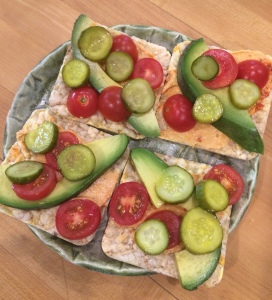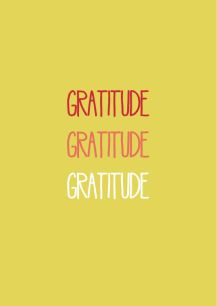What would I recommend for lunch to someone who’s looking to loose weight and boost his or her health? Pretty much the same thing that a healthy person at their ideal weight might eat. Clients often ask for specific recommendations. What follows isn’t a meal plan, but provides some guidelines for assembling a nutritious, fresh lunch that won’t show up on the scale.
You’re on the right track when your meals hit just about all of the following eight notes. As an example, I’ll use my own lunch to illustrate these points.
Today I enjoyed Suzie’s Whole Grain Thin Cakes (found them at Whole Foods and am trying them for the first time – good!), topped with roasted red pepper hummus, avocado, cherry tomatoes, and dill pickles.
Fat – Although the Thin Cakes are fat free, both the hummus and avocado contain a nice dose of healthy fats – about 5 grams from the hummus and 13 grams from the ½ avocado. That’s plenty to fuel the body for the rest of the afternoon and provide satiety now.
 Fiber – Every ingredient — veggies, cracker and hummus — offers plant-based fiber which helps us feel full and our digestive system run smoothly. The avocado alone has 8 grams of fiber.
Fiber – Every ingredient — veggies, cracker and hummus — offers plant-based fiber which helps us feel full and our digestive system run smoothly. The avocado alone has 8 grams of fiber.
Protein – The Thin Cakes are made with corn, quinoa, and sesame, so five thin crackers have almost 3 grams of protein. The hummus added 2 and the avocado 3 grams. The veggies contribute some as well. NB: a plant-based meal can provide plenty of protein.
Carbohydrates – Key for energy, and in this meal, they are complex carbs; none are refined. The avocado has 8 grams, tomatoes 10, and the hummus 6.
Vitamins & Minerals
Iron – avocado
Potassium – avocado
Sodium – pickles and hummus
Vitamin A – hummus and tomatoes
Vitamin C – tomatoes, avocado
Vitamin B6 – avocado
Missing from the meal are, among other things, calcium and vitamin D – something to think about when choosing foods for the rest of the day.
Taste & Texture – This meal has crunch from the crackers and pickles, creamy richness from the hummus and avocado, a burst of juicy flavor from the tomatoes. It tasted wonderful and was completely satisfying.
Color – An easy rule of thumb I share with clients is to create meals with deep, rich colors. The more variety and intensity usually indicates the meal contains a bunch of vital nutrients. Compare the color of a fresh garden tomato to its pale winter cousin in the grocery store. Or notice the deep orange yolk of an organic, free range egg.
Quick & Easy – The ingredients were all fresh and available. When packing a similar concoction for school or work, use separate containers and prepare it when you’re ready to eat.





 Chop raw vegetables and roast them. (
Chop raw vegetables and roast them. (